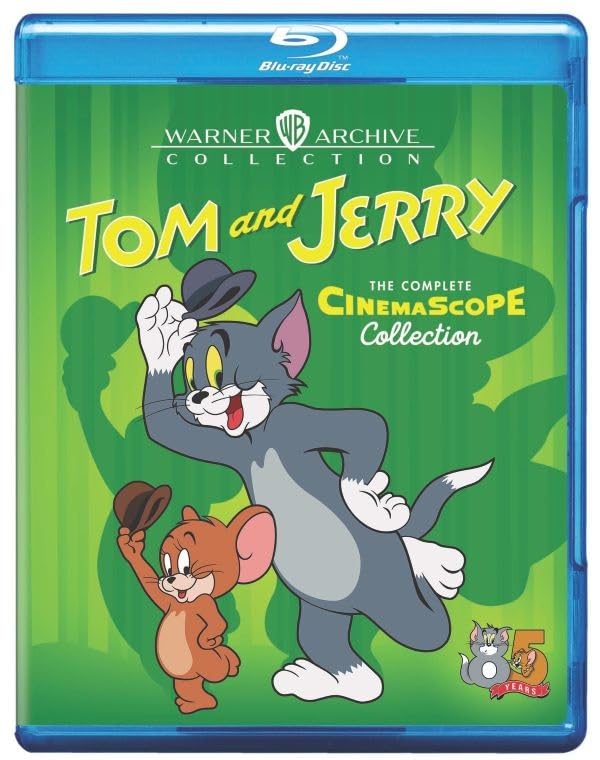
As part of the 85th anniversary celebration of Hanna-Barbera’s Tom and Jerry franchise, which began with their first cartoon, Puss Gets the Boot, Warner Bros. Entertainment has released Tom and Jerry: The Complete CinemaScope Collection, which presents in chronological order 23 theatrical cartoons released between 1954 and 1958 filled with the animated pair’s trademark slapstick violence. CinemaScope was one of the many attempts by movie studios, specifically MGM in this case, to compete with television. The new format presented an expanded widescreen image. All the cartoons here are presented in 2.35:1 aspect ratio, which gave the animators more space to make use of.
Buy Tom and Jerry: The Complete CinemaScope Collection Blu-rayDuring this era, the Tom and Jerry cartoons sees the pair joined by frequent co-stars. In Pet Peeve, George and Joan own Spike and Tom, but with the food bills they have generated they have to get rid of one. To determine which, depends on who catches Jerry. In Pup on a Picnic, Spike (now voiced by Daws Butler in the style of Jimmy Durante) and his son Tyke are off on a picnic. Of course, Tom and Jerry ruin their nice day out in the park. The basic premise was reused in Barbeque Brawl. Tops with Pops is a Cinema-Scope remake of Love That Pup (1949) with Tom and Jerry’s antics yet again bothering the dogs. In Tom’s Photo Finish, Tom frames Spike for raiding George and Joan’s refrigerator, but Jerry has photo proof that he keeps trying to slip to the humans.
Joan and George’s unnamed babyis the focus for two cartoons. In Busy Buddies, babysitter Jeannie is too busy on the phone to pay attention soTom and Jerry must work together to save him from the dangerous predicaments he gets into. Tot Watchers is more of the same with the baby getting in scarier situations. It’s notable for being the final Tom and Jerry cartoon of the Hanna-Barbera era, which is a shame as they went out with a repeated premise rather than doing something special.
Tuffy, Jerry’s talking nephew, appeared in four cartoons based around the Musketeers and three appear in this set. Touché Pussycat is a the prequel to The Two Mouseketeers (1952) and Tuffy has been sent to be trained by Jerry. In Tom and Cherie, Tuffy is tasked with delivering love letters for Jerry at great risk to himself. In Royal Cat Nap, the king warns Tom he does not want his nap disturbed, leading the mice to create some mischief.
Tuffy appears in two others in this set. Feedin’ the Kiddie is a CinemaScope remake of The Little Orphan (1949) and cousin George asks Jerry to take care of Tuffy for Thanksgiving. The problems arise as Tuffy “loves to eat!”He doesn’t speak here but in Robin Hoodwinked, where he and Jerry rescue Robin Hood, who is being guarded by Tom, he has an odd English accent.
Quacker is a young yellow duck whose voice and personality would later be seen in Hanna-Barbera’s Yakky Doodle. In Southbound Duckling, Quacker wants to head south for the winter even though he’s a domestic duck who can’t fly. Jerry tries to stop Tom from eating Quacker. When Tom accidentally hatches Quacker, the duck mistakenly thinks That’s My Mommy, but Jerry has to again come to the duck’s rescue. In Happy Go Ducky, the Easter Bunny leaves an egg that contains Quacker. He causes mayhem through the house, swimming in whatever he can. In The Vanishing Duck, George buys Joan Quacker as a birthday present. In a plot point similar to The Invisible Mouse (1947), Jerry and Quacker pester Tom by becoming invisible, using vanishing cream rather than invisible ink.
The remaining cartoons see Tom deal with a witch (The Flying Sorceress); Jerry mothering a baby woodpecker (The Egg and Jerry, a Cinema-Scope remake of Hatch Up Your Troubles [1949]); Tom and Butch the Cat competing for his girlfriend (Muscle Beach Tom); a jazz-loving, dancing bear (Down Beat Bear); Tom’s mouse-fearing cousin George (Timid Tabby); and Tom going to Spain to catch Jerry (Mucho Mouse). And in undoubtedly the strangest, darkest Tom and Jerry cartoon of this era, Blue Cat Blues, Jerry narrates how lost love has led to Tom to become suicidal.
The video has been given a 1080p/MPEG-4 AVC encoded transfer. The colors pop in strong hues. Blacks are inky and border the characters. The cartoons look clean with the image appearing free from dirt. Film grain quality depends on the short. Animated objects are well defined while some shorts have backgrounds where objects are loosely sketched. The audio is available in DTS-HD MA 2.0. The limited dialogue sounds clear. The sound effects, ranging from ambiance to violence and reaction to it, and the scores balance well together in the mix. The shorts sound free of hiss or defect.
There are three Bonus Cartoons. Good Will to Men is a CinemaScope remake of Peace on Earth (1939). On Christmas Eve, mice sing “Peace on Earth” in a bombed-out church. The preacher mouse explains what men are, creatures now extinct due to war. No explanation why the mice believe in the Bible rather than have their own mythology. Spike and Tyke have to deal with a dog who keeps stealing their licenses and the dogcatcher who wants to catch unlicensed dogs in Give and Tyke, and a group of cats who try to sneak into their masters’ home for a party in Scat Cats.
Although at the end of their run, Bill Hanna, Joe Barbera, and their team of animators deliver a lot of funny mayhem in these CinemaScope shorts, which fans expect from a Tom and Jerry cartoon. However, they didn’t taken full advantage of what widescreen format offered as it mainly feels like the backgrounds are just extended. But what’s here looks very good in high definition.